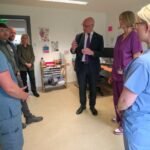In a time when NHS Scotland faces growing pressure from limited funding, an innovative approach to digital transformation might be the key to improving patient access without the need for significant new resources. While funding challenges persist, the strategic adoption of cloud telephony and digital tools presents an opportunity for NHS Scotland to future-proof its patient access systems, drawing inspiration from NHS England’s successful digital shift.
The Importance of Telephony in Patient Access
Phones are far from obsolete in the digital healthcare age. In fact, they remain the primary method by which patients interact with NHS practices. Figures from NHS Scotland reveal that a significant 68% of patients prefer accessing their GP practices via phone, highlighting the importance of modernizing the telephony infrastructure as a critical aspect of digital healthcare.
Despite the growing emphasis on online portals, websites, and apps, it is essential to recognize that phones are still the most reliable and inclusive option for patients, particularly those who may lack internet access or face challenges using digital platforms. For vulnerable groups, this remains a lifeline to essential services.

England’s Framework Success: A Model for Scotland
Across the border, NHS England has benefitted from the Better Purchasing Framework (BPF), which has played a significant role in facilitating the transition to advanced cloud telephony. As England prepares for the PSTN (Public Switched Telephone Network) switch-off, the BPF has allowed NHS practices to make a seamless transition, improving patient access and practice efficiency while avoiding costly disruptions.
However, NHS Scotland has not yet established a similar funded framework. Despite the challenges, experts believe there is still a path forward that doesn’t rely on large-scale national funding programs or bureaucratic procurement frameworks. This is where innovation at the local level can make a significant difference.
A Voluntary ‘Trusted Provider’ Model for Progress
One proposal gaining traction is the voluntary ‘Trusted Provider Agreement’ model, put forward by Think Healthcare in collaboration with Scottish Government. The model aims to bring the benefits of a formal procurement framework without the accompanying complexity, cost, or delays.
Under this model, Scottish GP practices would be able to access advanced telephony technology at preferential prices while being protected from unforeseen costs. This partnership could ensure practices adopt resilient, future-proof phone systems aligned with Scottish healthcare strategies and priorities, rather than applying generic solutions developed elsewhere.
Combining Traditional and Digital Access
The proposal centers on two key technologies:
-
Advanced Cloud Telephony: This provides a flexible, scalable, and resilient phone system with features like intelligent call routing, automatic callback, and real-time analytics. These features aim to reduce patient wait times and create more equitable access for vulnerable groups.
-
Virtual Care Navigator: This digital, phone-based tool empowers patients to complete common tasks—such as booking appointments or requesting prescriptions—without needing to speak directly to a receptionist. By reducing call volumes, it enables practice staff to focus on more complex patient needs.
Together, these technologies can create a hybrid model that enhances the ‘digital front door’ of primary care in Scotland, blending traditional access methods with modern innovations to meet the diverse needs of the population.
Taking Action Without Waiting for National Funding
While the adoption of cloud telephony in NHS Scotland may not be immediately funded at the national level, there is no reason why these innovative technologies cannot be implemented in the short term. By leveraging local partnerships with technology experts and aligning with Scottish strategies, NHS Scotland can start addressing its access challenges today.
In the face of challenges such as the PSTN switch-off, the time to act is now. Scotland has already proven its leadership in areas like digital prescribing and remote consultations. By applying similar innovative thinking to telephony infrastructure, the country can continue to set a standard in healthcare delivery that others will follow.
Building a Sustainable Foundation
The future of healthcare in Scotland does not necessarily hinge on large, immediate funding commitments. With the right partnerships, sustainable technology adoption, and a focus on long-term patient experience, Scotland’s NHS can continue to thrive and provide high-quality care. By modernizing core infrastructure such as telephony and embracing innovative solutions, Scotland has the potential to lead the way in transforming the digital front door to primary care.


















